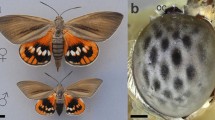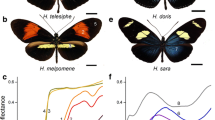Abstract
This review outlines our recent studies on the spectral organization of butterfly compound eyes, with emphasis on the Japanese yellow swallowtail butterfly, Papilio xuthus, which is the most extensively studied species. Papilio has color vision when searching for nectar among flowers, and their compound eyes are furnished with six distinct classes of spectral receptors (UV, violet, blue, green, red, broadband). The compound eyes consist of many ommatidia, each containing nine photoreceptor cells. How are the six classes of spectral receptors arranged in the ommatidia? By studying their electrophysiology, histology, and molecular biology, it was found that the Papilio ommatidia can be divided into three types according to the combination of spectral receptors they contain. Different types of ommatidia are distributed randomly over the retina. Histologically, the heterogeneity appeared to be related to red or yellow pigmentation around the rhabdom. A subset of red-pigmented ommatidia contains 3-hydroxyretinol in the distal portion, fluorescing under UV epi-illumination. The red, yellow and fluorescing pigments all play crucial roles in determining the spectral sensitivities of receptors. Spectral heterogeneity and random array of ommatidia have also been found in other lepidopteran species. Similarities and differences between species are also discussed.









Similar content being viewed by others
References
Arikawa K, Inokuma K, Eguchi E (1987) Pentachromatic visual system in a butterfly. Naturwissenschaften 74:297–298
Arikawa K, Mizuno S, Scholten DGW, Kinoshita M, Seki T, Kitamoto J, Stavenga DG (1999a) An ultraviolet absorbing pigment causes a narrow-band violet receptor and a single-peaked green receptor in the eye of the butterfly Papilio. Vision Res 39:1–8
Arikawa K, Scholten DGW, Kinoshita M, Stavenga DG (1999b) Tuning of photoreceptor spectral sensitivities by red and yellow pigments in the butterfly Papilio xuthus. Zool Sci 16:17–24
Arikawa K, Mizuno S, Kinoshita M, Stavenga DG (2003) Coexpression of two visual pigments in a photoreceptor causes an abnormally broad spectral sensitivity in the eye of a butterfly, Papilio xuthus. J Neurosci 23:4527–4532
Bandai K, Arikawa K, Eguchi E (1992) Localization of spectral receptors in the ommatidium of butterfly compound eye determined by polarization sensitivity. J Comp Physiol A 171:289–297
Bernard GD, Miller WH (1970) What does antenna engineering have to do with insect eyes? IEEE Student J 8:2–8
Briscoe AD, Bernard GD, Szeto AS, Nagy LM, White RH (2003) Not all butterfly eyes are created equal: rhodopsin absorption spectra, molecular identification and localization of UV-, blue-, and green-sensitive rhodopsin encoding mRNA in the retina of Vanessa cardui. J Comp Neurol 458:334–349
Chittka L, Briscoe AD (2001) Why sensory ecology needs to become more evolutionary—insect color vision as a case in point. In: Barth FG, Schmid A (eds) Ecology of sensing. Springer, Berlin Heidelberg New York, pp 19–37
Chou WH, Hall KJ, Wilson DB, Wideman CL, Townson SM, Chadwell LV, Britt SG (1996) Identification of a novel Drosophila opsin reveals specific patterning of the R7 and R8 photoreceptor cells. Neuron 17:1101–1115
Franceschini N, Kirschfeld K, Minke B (1981) Fluorescence of photoreceptor cells observed in vivo. Science 213:1264–1267
Frisch K von (1914) Der Farbensinn und Formensinn der Biene. Zool J Physiol 37:1–238
Gaertner W (2000) Invertebrate visual pigments. In: Stavenga DG, DeGrip WJ, Pugh ENJ (eds) Molecular mechanisms in visual transduction. Elsevier, Amsterdam, pp 297–388
Govardovskii VI, Fyhrquist N, Reuter T, Kuzmin DG, Donner K (2000) In search of the visual pigment template. Vis Neurosci 17:509–528
Hardie RC, Franceschini N, Ribi W, Kirschfeld K (1981) Distribution and properties of sex-specific photoreceptors in the fly Musca domestica. J Comp Physiol A 145:139–152
Hateren JH van (1989) Photoreceptor optics, theory and practice. In: Stavenga DG, Hardie RC (eds) Facets of vision. Springer, Berlin Heidelberg New York, pp 74–89
Kelber A, Henique U (1999) Trichromatic colour vision in the humming bird hawkmoth, Macroglossum stellatarum L. J Comp Physiol A 184:535–541
Kelber A, Pfaff M (1999) True colour vision in the orchard butterfly, Papilio aegeus. Naturwissenschaften 86:221–224
Kinoshita M, Arikawa K (2000) Colour constancy of the swallowtail butterfly, Papilio xuthus. J Exp Biol 203:3521–3530
Kinoshita M, Sato M, Arikawa K (1997) Spectral receptors of nymphalid butterflies. Naturwissenschaften 84:199–201
Kinoshita M, Shimada N, Arikawa K (1999) Colour vision of the foraging swallowtail butterfly Papilio xuthus. J Exp Biol 202:95–102
Kitamoto J, Sakamoto K, Ozaki K, Mishina Y, Arikawa K (1998) Two visual pigments in a single photoreceptor cell: identification and histological localization of three mRNAs encoding visual pigment opsins in the retina of the butterfly Papilio xuthus. J Exp Biol 201:1255–1261
Kitamoto J, Ozaki K, Arikawa K (2000) Ultraviolet and violet receptors express identical mRNA encoding an ultraviolet-absorbing opsin: Identification and histological localization of two mRNAs encoding short-wavelength-absorbing opsins in the retina of the butterfly Papilio xuthus. J Exp Biol 203:2887–2894
Lyubarsky AL, Falsini B, Pennesi ME, Valentini P, Pugh ENJ (1999) UV- and midwave-sensitive cone-driven retinal responses of the mouse: a possible phenotype for coexpression of cone photopigments. J Neurosci 19:442–455
Makino CL, Dodd RL (1996) Multiple visual pigments in a photoreceptor of the salamander retina. J Gen Physiol 108:27–34
Marshall NJ, Land MF, King CA, Cronin TW (1991) The compound eyes of mantis shrimps (Crustacea, Hoplocarida, Stomatopoda). 2. Colour pigments in the eyes of stomatopod crustaceans: polychromatic vision by serial and lateral filtering. Philos Trans R Soc Lond B 334:57–84
Marshall NJ, Jones JP, Cronin TW (1996) Behavioural evidence for colour vision in stomatopod crustaceans. J Comp Physiol A 179:473–481
Meinecke CC, Langer H (1984) Localization of visual pigments within rhabdoms of the compound eye of Spodoptera exempta (Insecta, Noctuidae). Cell Tissue Res 238:359–368
Menzel R, Backhaus W (1989) Color vision in honey bees: phenomena and physiological mechanisms. In: Stavenga DG, Hardie RC (eds) Facets of vision. Springer, Berlin Heidelberg New York, pp 281–297
Menzel R, Blakers M (1975) Functional organisation of an insect ommatidium with fused rhabdom. Cytobiology 11:279–298
Mollon JD, Bowmaker JK (1992) The spatial arrangement of cones in the primate fovea. Nature 360:677–679
Moody MF, Parriss JR (1961) The discrimination of polarized light by Octopus: a behavioral and morphological study. Z Vergl Physiol 44:268–291
Neumeyer C (1992) Tetrachromatic color vision in goldfish—evidence from color mixture experiments. J Comp Physiol A 171:639–649
Nilsson D-E, Land MF, Howard J (1988) Optics of the butterfly eye. J Comp Physiol A 162:341–366
Pichaud F, Briscoe A, Desplan C (1999) Evolution of color vision. Curr Opin Neurobiol 9:622–627
Qiu X, Arikawa K (2003a) The photoreceptor localization confirms te spectral heterogeneity of ommatidia in the male small white butterfly, Pieris rapae crucivora. J Comp Physiol A 189:81–88
Qiu X, Arikawa K (2003b) Polymorphism of red receptors: Sensitivity spectra of proximal photoreceptors in the small white butterfly, Pieris rapae crucivora. J Exp Biol 206:2787–2793
Qiu X, Vanhoutte KAJ, Stavenga DG, Arikawa K (2002) Ommatidial heterogeneity in the compound eye of the male small white butterfly, Pieris rapae crucivora. Cell Tissue Res 307:371–379
Ribi WA (1978) A unique hymenopteran compound eye. The retina fine structure of the digger wasp Sphex cognatus Smith (Hymenoptera, Sphecidae). Zool Jahrb Abt Allg Zool Physiol Tiere 100:299–342
Roorda A, Williams DR (1999) The arrangement of the three cone classes in the living human eye. Nature 397:520–522
Sakamoto K, Hisatomi O, Tokunaga F, Eguchi E (1996) Two opsins from the compound eye of the crab Hemigrapsus sanguineus. J Exp Biol 199:441–450
Seki T, Fujishita S, Ito M, Matsuoka N, Tsukida K (1987) Retinoid composition in the compound eyes of insects. J Exp Biol 47:95–103
Stavenga DG (1979) Pseudopupils of compound eyes. In: Autrum H (eds) Handbook of sensory physiology. Springer, Berlin Heidelberg New York, pp 357–439
Stavenga DG (2002a) Colour in the eyes of insects. J Comp Physiol A 188:337–348
Stavenga DG (2002b) Reflections on colourful ommatidia of butterfly eyes. J Exp Biol 205:1077–1085
Stavenga DG, Smits RP, Hoenders BJ (1993) Simple exponential functions describing the absorbance bands of visual pigment spectra. Vision Res 33:1011–1017
Stavenga DG, Oberwinkler J, Postma M (2000) Modeling primary visual processes in insect photoreceptors. In: Stavenga DG, DeGrip WJ, Pugh ENJ (eds) Molecular mechanisms in visual transduction. Elsevier, Amsterdam, pp 527–574
Stavenga DG, Kimoshita M, Yang E-C, Arikawa K (2001) Retinal regionalization and heterogeneity of butterfly eyes. Naturwissenschaften 88:477–481
White RH, Xu H, Munch T, Bennett RR, Grable EA (2003) The retina of Manduca sexta: rhodopsin-expression, the mosaic of green- blue- and UV-sensitive photoreceptors and regional specialization. J Exp Biol (in press)
Yokoyama S, Yokoyama R (2000) Comparative molecular biology of visual pigments. In: Stavenga DG, DeGrip WJ, Pugh ENJ (eds) Molecular mechanisms in visual transduction. Elsevier, Amsterdam, pp 257–296
Acknowledgements
I first want to express my thanks to the editor of this journal for encouraging me to write this review. Drs D.G. Stavenga and M. Kinoshita, and two anonymous referees provided critical comments on the manuscript. The work was supported by Grants-in-Aid for Scientific Research from the Ministry of Education, Culture, Sports, Science, and Technology of Japan (MEXT) and by the PRESTO program of the Japan Science Technology Corporation (JST).
Author information
Authors and Affiliations
Corresponding author
Rights and permissions
About this article
Cite this article
Arikawa, K. Spectral organization of the eye of a butterfly, Papilio . J Comp Physiol A 189, 791–800 (2003). https://doi.org/10.1007/s00359-003-0454-7
Received:
Revised:
Accepted:
Published:
Issue Date:
DOI: https://doi.org/10.1007/s00359-003-0454-7




